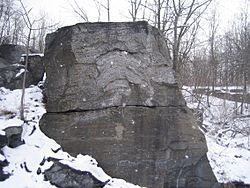Chazy Fossil Reef facts for kids
Quick facts for kids Chazy Fossil Reef |
|
|---|---|

Stromatoporoid at Fisk Quarry, Isle La Motte, Vermont
|
|
| Lua error in Module:Location_map at line 420: attempt to index field 'wikibase' (a nil value). | |
| Location | Clinton County, New York Grand Isle County, Vermont |
| Area | 1,567 acres (6.34 km2) |
| Governing body | Mixed (federal, state, and private) |
| Designated: | May 2009 |
The Chazy Fossil Reef is a super old and important place. It's a special National Natural Landmark in the United States. You can find it on three islands in Lake Champlain, which is a big lake between New York and Vermont.
This site is famous for being the oldest known fossil reef in the world. It has many different kinds of ancient sea creatures. You can even see how different creatures lived and died over millions of years. This shows how life changed over time, which scientists call faunal succession. This amazing 1,567-acre (6.34 km2) area became a special landmark in May 2009.
Contents
Where to Find the Chazy Fossil Reef
The Chazy Fossil Reef National Natural Landmark is spread across three islands in Lake Champlain. These islands are part of both New York and Vermont.
Islands You Can Visit
Two of the islands are in Vermont and are open for people to explore:
- The Fisk Quarry Preserve is about 20-acre (8.1 ha) big.
- The Goodsell Ridge Preserve is about 83-acre (34 ha) big.
Both of these places are on an island called Isle La Motte. A group called the Isle La Motte Preservation Trust takes care of them.
Other Islands in the Landmark
The landmark also includes two islands in New York:
- Valcour Island
- Garden Island
Amazing Ancient Fossils
The Chazy Fossil Reef is a part of a much larger rock layer called the Chazy Formation. This formation stretches all the way from Quebec in Canada down to Tennessee in the United States!
A Peek into the Past
At this site, you can see parts of an ancient Ordovician fossil reef. This reef is incredibly old, about 450 to 480 million years old! Back then, this area was a warm, tropical ocean. The reef is special because it's the oldest known fossil reef that has so much different biological diversity (many different types of life).
Seeing Time Pass in Rocks
The layers of rock at the reef are tilted. This means you can see different time periods as you walk across the land. The oldest fossils are found at the southern end of Isle La Motte. As you move north, you'll see fossils from newer time periods. This allows scientists to study how life changed over millions of years.
What Kinds of Fossils Are There?
You can find many different kinds of ancient sea creatures preserved here. Some of them include:
- Prehistoric stromatoporoids (like ancient sponges)
- Gastropods (ancient snails)
- Cephalopods (like ancient squid or octopuses)
- Echinoderms (like ancient starfish)
- Brachiopods (shelled creatures)
- Sponges
- Coral
- Bryozoa (tiny colonial animals)
- Stromatolites (layered rocks made by ancient bacteria)

